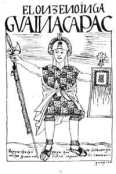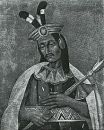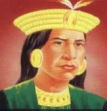Hello! This is part eighteen of a multi-part series on the Inca Empire and the Conquistadors. If you want some background, the introduction to this series is right here, and part seventeen is here. For those of you who like to have no idea what’s going on, go ahead!
Almagro was dead. The first and only governor of New Toledo lay six feet under ground, executed by Hernando in the town square. Manco Inca had retreated into the Antisuyu. This left Pizarro the de facto ruler of almost all of Peru and large swathes of Chile.
After seven years of fighting and twelve years since his first voyage to Peru, the bastard son of a minor nobleman was now the most powerful man in the New World. Pizarro was the royal governor of New Castille, a knight of the Order of Santiago, and richer than everyone in Spain except the king.
Despite his newfound wealth and power, Pizarro kept to his humble origins. He was famed for preferring the company of sailors, soldiers and laborers, and he could often be found playing quoits and bowling in the dusty streets of Lima.

Meanwhile, Manco Inca had pulled his followers back into the Antisuyu, among the fierce Antis people who had resisted the Inca army so mightily a generation ago. First he settled in Vitcos, but Vitcos proved to be to close to the Spanish, so Manco Inca plunged into the jungle, finally settling in the trading outpost of Vilcabamba. Vilcabamba was a city on the very edge of the Inca empire, right at the boundary marker between civilization and the jungle (three hundred and fifty years later, when the Incas and the conquistadors alike were long dead, the lost city of Vilcabamba, swallowed by the jungle, attracted adventurers/archaeologists from around the globe. The man who eventually found it, Hiram Bingham, was potentially the inspiration for Indiana Jones).
From Vilcabamba, Manco Inca began to organize rebellions across Peru. He knew he couldn’t defeat the Spanish in the field, but Manco Inca was still viewed as the divine ruler across the whole empire, and he still had a vast network of spies and messengers to draw on. Messages were spread across the empire, and soon bands of Inca warriors began raiding the roads, killing native collaborators, capturing any Spaniards and torturing them horribly before killing them.
Pizarro was not complacent in the face of these rebellions, and he ordered several brutal counterinsurgency operations against the areas that rebelled. The Spaniards also launched two major invasions of Manco Inca’s rebel kingdom. Both of them – Orgonez’s attack on Vitcos in 1537 and Gonzalo Pizarro’s attack on Vilcabamba in 1539 – were great successes in many regards. In both instances the Spaniards defeated the Incas, sacked the city, and took many valuables back, even capturing Manco Inca’s close family members – Manco’s son and heir Titu Cusi in 1537, and his wife Cura Occlo in 1539.
However, each time Manco Inca evaded capture, and his Inca troops were beginning to show signs of adapting the Spaniards’ military technology. At the battle of Vilcabamba Manco’s troops shoved captured arquebuses through gaps in the walls, firing on the Spaniards as they scaled the rough stone.
Manco Inca had even begun to ride, and in an early skirmish he and three other warriors mounted on captured horses and wielding captured lances had horrified a band of thirty Spanish soldiers. Manco and his men charged downhill, slamming into the surprised soldiers with crushing force and spearing left and right with their lances. The Spanish fell back in disarray, pursued by Manco and a mass of Inca foot soldiers. Twenty eight of thirty Spaniards were killed in that charge and the subsequent pursuit, Manco’s first use of cavalry.
Manco Inca was not going anywhere, and he would continue to be a thorn in the side of the Spaniards for years.
However, besides for Manco Inca, Pizarro’s rule was fairly untroubled. He was the most powerful man in Peru, and he and his brother Gonzalo ruled over a governorship as large and richer than Spain itself. While Pizarro himself continued to dress plainly, as he always had, his followers began to wear extravagant clothes and jewelry,
The original entrepreneurs had struck it rich, richer than they ever could have imagined, and they reveled on their status, surrounded by all the gold, silver and women they could ever want. Life was good for Pizarro and his men.
Unfortunately for Pizarro, it couldn’t last.
Dates
c. 1200 Kingdom of Cuzco is founded
1438-1471 Reign of Pachachuti
1471-1493 Reign of Tupac Inca
1492 Columbus discovers the Americas
1493-1527 Reign of Huayna Capac
1526 Pizarro and his thirteen men discover the Inca city of Tumbez
1527 Huayna Capac dies of smallpox brought by the Europeans
1527-1531 Civil war between Atahualpa Inca and Huascar
1531 Pizarro’s conquering expedition to Peru, Pizarro captures Atahualpa Inca, Atahualpa executes his brother Huascar
1533 Pizarro executes Atahualpa Inca and installs Manco Inca as the new Inca
1535 Pizarro founds the city of Lima
1536 Manco Inca rebels against the Spanish, leads a massive uprising that traps them in Cuzco and Lima. Juan Pizarro is killed in the battle
1537 Diego Almagro seizes Cuzco from the Pizarros. Manco Inca retreats from the capital to Vilcabamba
1538 Hernando Pizarro defeats and executes Almagro
1540 Hernando Pizarro is sentenced to twenty years imprisonment in Spain for killing Almagro.
Characters
Incas

Huayna Capac – Emperor of the Incas [Died of plague in 1527]

Huascar – Son of Huayna Capac and the heir to the throne [Executed by Atahualpa in 1531]

Atahualpa – Brother of Huascar and rival for the throne, emperor of the Incas [Executed by Pizarro in 1533]
 Manco Inca – Younger brother of Atahualpa and Huascar, emperor of the Incas [Ruling in exile in Vilcabamba starting in 1537]
Manco Inca – Younger brother of Atahualpa and Huascar, emperor of the Incas [Ruling in exile in Vilcabamba starting in 1537]
The Pizarros
 Francisco Pizarro – Oldest of the brothers and mastermind of the expedition. A talented leader of men and a good strategist
Francisco Pizarro – Oldest of the brothers and mastermind of the expedition. A talented leader of men and a good strategist
Hernando Pizarro – Second of the brothers; a canny and calculating tactician [Sentenced to twenty years in prison in Spain in 1540]
Gonzalo Pizarro – Third brother; charming womanizer with a vicious cruel streak
Juan Pizarro – Youngest of the brothers and a powerful, impetuous soldier [Killed during the Siege of Cuzco by Manco Inca’s forces in 1536]
Almagristas

Diego Almagro – Partner with Pizarro and one of his oldest friends, a hardened veteran of many battles ready to strike it rich [Executed by Hernando Pizarro in 1538]
Diego Almagro II – Almagro’s son, a hot-headed young soldier
Royalists
 Cristobal Vaca de Castro – Viceroy of Peru, a flexible and adaptable man
Cristobal Vaca de Castro – Viceroy of Peru, a flexible and adaptable man
 Blasco Nunez Vela – Viceroy of Peru, grating and brusque administrator
Blasco Nunez Vela – Viceroy of Peru, grating and brusque administrator
 Pedro de la Gasca – Viceroy of Peru, a clever politician and adept manipulator
Pedro de la Gasca – Viceroy of Peru, a clever politician and adept manipulator
One thought on “Chapter 18: The New Rulers of Peru”